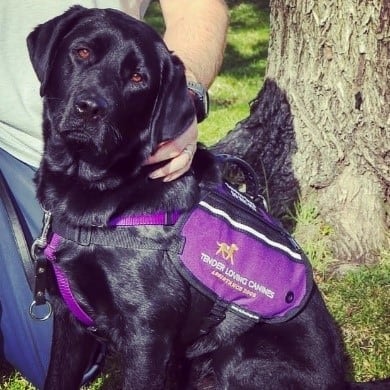[This story was written for the blog and first appeared in the NODCC’s August newsletter.]
by Chris Tompkins
On January 31, 2020, I brought home a service dog (Chance) for my 11-year old son who has hypoplasia of the corpus callosum (HCC), visual impairments, neurodevelopment delays, and falls within the autism spectrum. This post summarizes my family’s journey in welcoming a service dog into the family in hopes that others will find it informative and helpful.
The Background: My wife and I love Labrador Retrievers and began our lives together “parenting” two lab dogs even before we thought about having kids. Once we decided to have children, I was comfortable with the temperament and gentle nature of our furry family members and knew they would learn to love our children. When our son was born, we noticed early on that he had delays. He was formally diagnosed with HCC at 13 months old. As our son grew, we noticed our chocolate lab was a little more receptive to our son and would try to comfort him during times of behavioral issues, while our yellow lab would just leave the room. My wife and I always thought our chocolate lab would have been a great service dog, which put the idea in our heads that if an opportunity presented itself in the future, we would look into how a service dog might be able to assist our son in his goal for independence.

Chance joined the Tompkins family in January 2020.
The Research: Several years later as our dogs started showing signs of age, my wife and I started to research service dogs for children with special needs. Through this research and connecting with friends, we learned about an organization that breeds, trains, and provides service dogs to individuals with disabilities at little cost. However, upon applying to this organization via an online intake form, we were notified that our son did not have the physical disabilities to qualify for the type of service dogs that the organization trained. The organization specialized in training service dogs to assist individuals in wheelchairs and/or with physical disabilities such as amputations or muscular sclerosis. At that point, my wife and I were starting to give up on the idea of getting a service dog until were learned of a non-profit organization called Tender Loving Canines (TLC, now merged with Guide Dogs of America). TLC specializes in training service dogs for children with autism and was accepting service dog applications within our geographic region. In short, it is important to acknowledge that there are service dog organizations that specialize in training dogs for specific purposes. Although this was frustrating at first, this level of specialized training in fact is a benefit and aids in the ability to “match” the dog’s skills and training to the needs of the individual, which enhances long-term compatibility and bonding.
The Application Process Begins: TLC uses a training program called POOCH. The dogs are trained in prisons by incarcerated trainers who are trained and supervised by TLC staff members. The dogs are trained to perform baseline cues/skills. Once the dog is matched with a client, the incarcerated trainers continue to train the dogs on custom assistive tasks which are cues/skills designed to assist the client in preparation for graduation and home placement. We applied to TLC online and had a follow-up telephone interview to discuss our son’s needs for a service dog. During the phone interview, I was amazed to learn about the different ways a service dog can assist an individual with autism. To start the eligibility process, the phone interview focused on identifying at least four ways in which a service dog would benefit our son. The four needs we identified were: 1) developing independence; 2) socialization; 3) mobility; and 4) sleep issues (I lay on my son’s floor every night for him to fall asleep).

Meeting Chance the Service Dog: After completing the online training, I felt confident in my ability and understanding of how to care for and maintain the training of a service dog. Once I started the one-week in-person training, I quickly realized that the online training only scratched the surface of what having a service dog entails. The in-person training I attended was in Southern California at the Guide Dogs for America campus, which provided me complementary room and board during my stay. On the first day, about an hour after I arrived, I was introduced to “Chance.” From that point on, everywhere I went, Chance was with me to help establish a bond between me as the handler and Chance the service dog. Trainings were from 8am – 5pm Monday through Friday and included four other clients and their matched service dogs. We did classroom training and off-campus trainings at the local mall, airport, pet store, and community areas all in preparation for a public access test that the handler and service dog must pass by the organization’s standards before the service dog can come home with you. Chance and I passed the training and we went home on Friday at the end of the training.
Bringing Chance Home: What I was not prepared for was how overwhelmed I would be once returning home to my family’s routine and introducing Chance into our family. The training prepares you for this but learning about it and experiencing it are two different things. It is important to understand that a service dog is not a pet. 
Follow the inspiring life adventures of Chance and his favorite boy on Instagram @myboy.myworld

